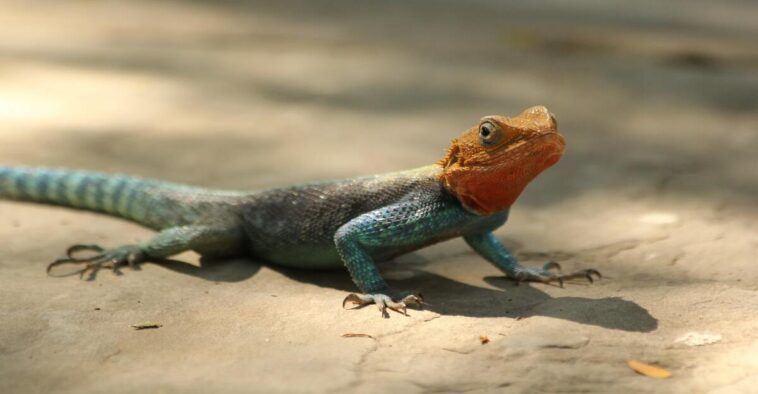Lizards are reptiles with different colours. There are over 6,000 known species of lizards in the world today. These animals are cold-blood like all other reptiles. Most live on land, some in burrowers and others on trees. A few lizards are without legs (snakelike), while others have four legs with which they walk around with their long tail.
Insects and other small animals are food for some lizards, and some feed on plants. The largest species of lizards can prey on and feed large animals like the water buffalo.
There are different types of lizards, such as frilled lizards, caiman lizards, monitor lizards, and so on.
Do Lizards Change Color?
Yes, lizard species like the chameleons and the Carolina anoles change their colour, while many other species do not.
Lizards that change their colours do so on purpose. They change their colour to attract their mates or to absorb heat from the sun. To camouflage and attack prey or escape predators, lizards change their colours.
Some species of lizards can disappear and reappear lines or patterns on their skin; some change from bright colours to dark colours or dark colours to bright colours with a specific purpose.
How Do Lizards Change Their Color?
These lizard species that can change colours have melanophores in their skin. It is a special pigment cell. This pigment cell is specially meant for lizards to change their skin colour when they want to.
The colour a lizard can change is dictated by the number or concentration of granules of melanophores in its skin. A high concentration of pigment granules in their melanophore results in the lizard’s bright colour; when the granules disappear, the colour becomes dark.
Do Chameleons Change Colors?
Chameleons with the ability to change their colour do so in response to temperature or environment change or to escape from their predator’s attacks. There are some facts about chameleons that we should know.
- Chameleons are also classified as lizards. These species of lizard’s narrow feet, the unique shape of their head, and their fast tongue differentiate them from other species of lizards.
- Over 100 species are recorded, and although their appearance differs, they can change colour.
- Chameleons are equipped with long, fast, and sticky tongues to trap and swallow insects.
- Chameleons have both males and females. Many males are known to have three horns as a defensive measure, that is, to fight and defend themselves from their predators. They also fight other chameleons, though.
- Where you can find these species and populations are mostly in southern Europe, Africa, the Indian subcontinent, and the Arabian peninsula.
- Anoles lizards are usually found in North America. Because of their ability to change colours, people refer to them as chameleons, but they are not though they are close brothers to chameleons.
How Does A Chameleon Change Its Color?
We said earlier that lizards change due to the melanophores in their skin that enable them to change colour, and for many years, people have also believed that it makes chameleons change their colour too. Though it is true. But recently, researchers have found that a different cell majorly plays the role of helping chameleons in their colour-changing ability. These cells are called iridophores. Melanophores are said to play a minor role in the colour-changing of chameleons.
If you can understand how prisms manipulate light, you will understand how chameleons change their colour, similar to how Iridophores manipulate light to help chameleons change.
Prisms are glass-made triangular boxes that, when light enters, disperse that light and split into different colours. Lights can disperse from a prism because the different colours of lights travel at the same speed when they enter a vacuum. On the contrary, the light of different colours travels at a different speed when it hits a different material, like glass, making it visible.
This implies that there’s always refraction and travelling of different light colours at different speeds when light hits a prism.
Though iridophores in chameleons are not made of glass like the prisms, they are said to have countless guanine crystals. These are arranged so that the top layer determines what wavelengths of white are reflected and seen.
A change in the arrangements and distancing of the guanine crystal in iridophores result in the wavelengths of white light that will reflect and be visible as the colour of the chameleon.
So the colour seen in chameleons is largely determined by the iridophores in their skins.
How Do Other Lizards Change Their Color?
Similar to how chameleons change their colour, other lizards also change theirs by manipulating the arrangements of the iridophores in their skin cells or changing the natural pigments to alter the reflection of their skin lights.
Lizards that lack melanophores and iridophores or the natural pigments in their skin cannot manipulate and change their skin colour.
Why Do Lizards Change Their Colors?
Most lizards change their colour not because they want to do it or because they are commanded to; rather, they change their colour in response to their environment. The hormones in their body enhance the change once they assess and see the need to change their colour.
To absorb more light, they can subconsciously change from bright to dark.
Also, the reasons for attracting their mates, hiding from predators, or lizards change their colours when the need to ambush their prey arises.
Recommended:
Conclusion
From what we have discussed, we have established that lizards change their colours, but not all do so.
Lizards like the chameleons that change their colour possess melanophores (pigment-containing cells) and iridophores (crystal-containing cells) in their skin that enable them to change their colour. Others change their skin colour with natural pigments (like Melanie). When they change their colour, it happens for a reason; responding to their surroundings.
